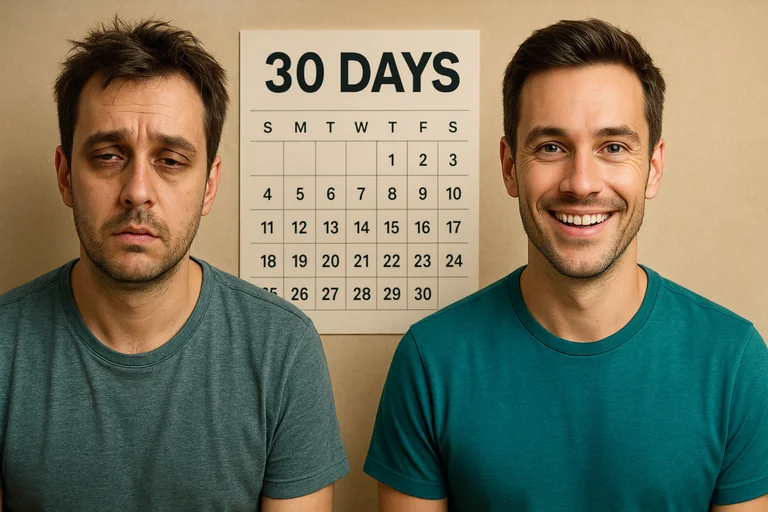A 2 minute assessment to get a personalized mental health or alcohol recovery plan.
Don’t let the marketing hype outweigh the reality of how many calories are in whiskey, and why the calorie count isn’t even the worst dietary consequence.
What You’ll Discover:
- How many calories are really in whiskey.
- Why the calorie count isn’t the worst dietary drawback of drinking whiskey.
- How factors like proof affect whiskey’s calorie count.
- Options for cutting back on whiskey consumption.
Whiskey's reputation for having 100 calories per shot overshadows the much more important 36-hour metabolic shutdown. Sophisticated marketing has masked the weight loss sabotage that comes with whiskey drinking, along with a number of other related health issues.
Understanding the true impact of whiskey consumption, from those baseline 100 calories to the steakhouse dinners and whiskey flight indulgences, could be the wake-up call that finally explains why your "refined" drinking habits are undermining your fitness goals.
Is vodka your drink of choice? Find out how vodka calories compare.
Slowly Sipping Whiskey Won’t Change the Metabolic Shutdown
This amber-colored alcohol that’s posed as a refined, "sipping" spirit is consumed by millions, most of which have no idea about the consequences of each sip. While whiskey marketing promotes sophistication, tradition and moderation, the metabolic reality isn’t part of the brand identity.
Like other types of alcohol, whiskey has a profound impact on metabolism. When alcohol enters your system your body halts fat burning for up to 36 hours. This metabolic change happens regardless of how much and how slowly you sip.
The Metabolic Mayhem of Whiskey Addiction
For the people addicted to whiskey, their daily libation will keep them in a constant state of removing the liquid toxin rather than fat burning. Even drinking every other day is going to have a negative impact beyond the empty calories. It doesn’t matter if you strength train or do cardio. Your body will prioritize processing the alcohol and hold on to the fat almost all of the time.
The 100-Calorie Sophistication Scam
Standard 80-proof whiskey may be 100 calories per shot, but whiskey contains the same 7 calories per gram of alcohol as every other spirit, making it calorically identical to vodka, gin, and tequila. So the marketing hype around whiskey already doesn’t hold much water.
In fact, proof escalation could actually make whiskey a worse choice. Many premium whiskeys reach 90-120 proof, pushing calories to 112-150 per shot. Cask strength expressions can exceed 130 proof, which works out to be 160+ calories.
The pour size lie compounds the problem. While calorie calculations assume 1.5-ounce shots, whiskey culture encourages 2-3 ounce pours (133-200 calories).
The type of whiskey being consumed also doesn’t make a difference calorically. Bourbon, Scotch, rye and Irish whiskeys all contain identical calories at the same proof, despite marketing that suggests certain types are healthier.
Longer aging is another factor that doesn’t make a difference. Aging affects flavor, not calories. Evaporation can actually concentrate aged alcohol, increasing the calorie count.
Marketing That Glorifies Whiskey Consumption Despite Calories
There are a lot of ways that marketing is misleading in regards to whiskey consumption. All of the hype surrounding it conveniently leaves out the calories conundrums and bases the benefits on assumptions.
The most common marketing myths include:
- Quality over quantity marketing implies expensive whiskey equals moderate consumption, ignoring that premium whiskeys often have higher proof and calories.
- Neat consumption marketing suggests no mixers means whiskey is healthier, ignoring 100+ calories and metabolic disruption.
- "Appreciation" framing makes whiskey drinking feel cultural rather than caloric.
- Ritual emphasis creates elaborate events around consumption so it feels meaningful rather than metabolically damaging.
- Price-health confusion creates false impressions that expensive equals healthy. Price has zero correlation with metabolic impact.
- Investment mentality justifies purchases as collectibles rather than alcohol, creating psychological distance from the health reality.
- Exclusivity marketing makes consumption feel like elite membership, creating pressure to maintain drinking for social status.
- Limited editions encourage consumption "before they're gone," overriding health considerations with urgency.
The Truth About Calories in Different Whiskies
Bourbon: America's Calorie Trap
- Standard 80-proof bourbon: 100 calories per shot.
- High-proof popularity pushes premium bourbons to 90-120 proof (112-150 calories). Barrel-proof exceeds 160 calories.
- Production methods don't affect calories despite "natural" marketing claims.
- Wheated variations maintain identical calories at equivalent proof despite "smoother" marketing.
- Craft explosions often feature higher proof and correspondingly higher calories.
- Flavored additions like honey bourbon add sugars pushing calories to 110-130 per shot.
Scotch: Highland Deception
- Single malts are 100 calories at equivalent proof. Purity marketing means nothing metabolically.
- Regional variations differ in taste, not calories. Marketing emphasizes territory while ignoring impact.
- Age statements don't reduce calories. Aging doesn't eliminate metabolic disruption.
- Cask strength delivers 120-140 calories versus 100 for standard versions.
- Peat doesn't matter calorically. Smoking affects taste, not nutrition.
Irish Whiskey: Smooth Sabotage
- Triple distillation doesn't reduce calories or metabolic impact.
- Pot still whiskey is the same as column still calorically, despite quality claims.
- Flavored options add sugars increasing the calorie count.
- Premium positioning often involves higher proofs with more calories.
Rye: Spicy Deception
- Rye content doesn't affect calories compared to other types of whiskey.
- Spiciness marketing creates false quality impressions unrelated to health.
- Craft popularity leads to high-proof expressions (110-140 calories).
- "Authentic" positioning creates cultural consumption justifications.
- Cocktail integration often means high-calorie mixed drinks.
Cocktail Calorie Catastrophe: When Whiskey Isn’t on Its Own
Old Fashioned: Classic Destruction
- Old Fashioneds pack 150-200 calories from whiskey, sugar and garnish.
- Sugar additives from simple syrup to muddled cubes add 50-60 calories per ounce.
- Premium versions use larger pours pushing calories to 200-250.
- Craft variations with multiple syrups exceed 300 calories.
Manhattan: Sophisticated Sugar
- Manhattans contain 160-200 calories from whiskey and sweet vermouth.
- Vermouth adds 30-40 calories per ounce through residual sugars.
- Cherry garnishes add 20-30 calories through sugar content.
- Premium escalation doesn't reduce calories despite ingredient quality.
Whiskey Sour: Citrus Calorie Bomb
- Whiskey Sours deliver 200-250 calories from whiskey, syrup and citrus.
- Simple syrup adds 50-80 calories through concentrated sugar.
- Egg white adds 15-20 calories without offsetting impact.
- Garnishes add 25-40 calories from fruits and syrups.
Mint Julep: Southern Sabotage
- Juleps contain 180-220 calories from bourbon whiskey and syrup.
- Syrup is the second-largest ingredient (60-80 calories).
- Traditional methods often add more sugar through muddling.
- Cultural justifications encourage overconsumption during celebrations.
Tasting Culture Calorie Traps
There are a few other aspects of whiskey drinking during the act that pack on extra calories. The culture around it can really add to the issue if you’re trying to avoid excess calories and burn fat.
How the Culture of Whiskey Drinking is Working Against You
- Premium tastings involve multiple 1-ounce pours adding up to 300-500 calories.
- Flight consumption with multiple small pours creates a visual illusion that makes you forget how much alcohol you’re drinking.
- Palate cleansers add 100-200 calories through crackers and cheese.
- Social pressure encourages consuming all samples offered.
- Extended drinking sessions can deliver 400-600 calories over 2-3 hours.
- Investment paradox drives drinking expensive whiskeys to justify purchase.
Reducing Whiskey Consumption and Empty Calories While Staying Social
If you’re the type that enjoys drinking socially but doesn’t like the idea of consuming hundreds of empty calories that will delay fat burning for more than a day, we’ve got some advice:
- Partaking in tastings allows you to participate and appreciate through samples, not servings.
- Alternating whiskey drinks with non-alcoholic options reduces total alcohol intake.
- Reduce the days that you drink to create recovery periods for fat burning.
- Choosing non-alcoholic spirits provides refreshment without metabolic damage.
- Opting for whiskey-flavored options offer familiar tastes minus alcohol.
- Ordering sophisticated mocktails satisfies the palette without the alcohol.
- Substituting tea or coffee provides complex flavors and can support weight loss.
If Whiskey Addiction is a Concern Skip the Mocktails and Get Professional Support
If the compulsion to drink whiskey is more about the buzz than the taste and social interaction, then it may be time to take a longer break from alcohol. Today, there are options for treating addiction to whiskey no matter where they live thanks to telehealth platforms and virtual meetings.
One-on-One Counseling: There are a variety of cognitive behavioral therapies that are used to address compulsive alcohol consumption..
Structured Whiskey Addiction Programs: Both in-patient and out-patient programs offer structured treatment plans that are closely supervised by medical professionals.
Support Groups: Both in-person and online support groups provide a community that helps normalize sobriety.
Medication-Assisted Treatment For Alcohol Addiction: Patients can get naltrexone medication online that is delivered to their home to help curb alcohol cravings.
The relationship between whiskey drinking and successful weight loss is fundamentally incompatible for most people. But beyond that, the metabolic mayhem and other health risks associated with alcohol consumption are even more harmful.
If you're tired of whiskey derailing your fitness goals, professional support can help you develop a healthier relationship with alcohol. Our Alcohol Use Assessment will give you a better idea of what options are available to help you reduce or eliminate alcohol.
References
[1] Alcohol Professor. (2023). How Long Does Alcohol Stop Fat Burning? https://www.alcoholprofessor.com/blog-posts/how-long-does-alcohol-stop-fat-burning
[2] Cederbaum, A. I. (2012). Alcohol metabolism. Clinics in liver disease, 16(4), 667-685. https://www.ncbi.nlm.nih.gov/pmc/articles/PMC3484320/
[3] Center for Science in the Public Interest. (2022). Which alcoholic beverages have the most (or least) calories? https://www.cspinet.org/article/which-alcoholic-beverages-have-most-or-least-calories




